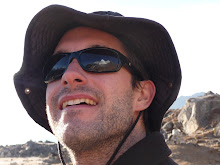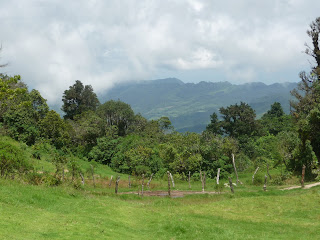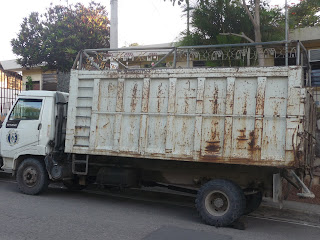Joey, Jose and I show our El Salvador pride
No not the country. It’s a section in the Cuscatlán Stadium, home of La Selecta, El Salvador’s national soccer team where last week I attended a game. I had been looking forward to the game for weeks. Although El Salvador had been eliminated from World Cup qualifying the week before, there was still excitement in the air. The game was a sold out. It was a game for pride against Honduras.
When I went to buy a ticket I had a choice to make: Vietnam, or not Vietnam. I had friends who insisted Vietnam was the real experience and I had to buy the $5 ticket that would get me into the “people’s section”, a sometimes explosive mass of passion, sweat and testosterone. My host family and some other friends counseled against it. They had always been too afraid to go into Vietnam. Stories of assaults and general anarchy abounded.
Of course, the choice was obvious. Vietnam it was.
So a fellow classmate, Joey, and a new El Salvadoran friend, Jose, and I set out for the stadium and the 6:00p.m. game. I had a disposable camera in my pocket, so as to not risk losing my digital camera (hence the pics aren’t very good). The afternoon started off well. As we waited for the bus, a pick-up truck full of young Selecta fans stopped and offered us a ride.
When I went to buy a ticket I had a choice to make: Vietnam, or not Vietnam. I had friends who insisted Vietnam was the real experience and I had to buy the $5 ticket that would get me into the “people’s section”, a sometimes explosive mass of passion, sweat and testosterone. My host family and some other friends counseled against it. They had always been too afraid to go into Vietnam. Stories of assaults and general anarchy abounded.
Of course, the choice was obvious. Vietnam it was.
So a fellow classmate, Joey, and a new El Salvadoran friend, Jose, and I set out for the stadium and the 6:00p.m. game. I had a disposable camera in my pocket, so as to not risk losing my digital camera (hence the pics aren’t very good). The afternoon started off well. As we waited for the bus, a pick-up truck full of young Selecta fans stopped and offered us a ride.
Party in the truck...
Getting ready for the big game
Outside the stadium
We arrived at the stadium, grabbed a couple beers and then made our way into the madness.

Inside Vietnam, police on ready
As we entered, fans were doing something very familiar: rowing. Everyone in Vietnam was sitting down, holding onto the shoulders of the person in front of them, and rowing front and back. It’s one of the activities of the UW-Madison student section during home football games. Good start. I then looked around, and noticed the fences keeping the Vietnam section cordoned off, particularly from the section of 10,000 rowdy Honduran fans. Maybe not so great a sign… Nonetheless, I felt a rush of energy as we made our way to our seats (unassigned, of course).
In other ways the scene also reminded me of UW football games. There was immense pride, plenty of vulgarity, a joyous belligerence. Plus many spectators had a pretty good buzz going. But there were definitely also departures from the UW parallel, and these departures are what most define Vietnam.
As we walked to our seats, we got noticed. As the attention of hundreds of fans turned our way, chants of “Gringo, culero!” began. Gringo is a somewhat derogatory (but not really) name for white people, and culero is an offensive epithet for homosexuals. Hands reach out to pull at our hair, and Joey felt drops of spit raining down. I should say that, while offensive, the insults did come with a smile. People weren’t angry; they were reveling in the culture of Vietnam.
In response, I did what came naturally: I looked up, smiled and waved. Horrified, Jose grabbed my hand, pulled it down to my side, and hurried me along to our seats, like a mother scolding her mischievous child. I guess I wasn’t supposed to respond that way. But nothing else came of it and we made it to our seats where we were not bothered for the rest of the game.
Sitting in the first row of the second section, we had front row seats of the action: the treatment of other passers-by, not to mention a great view of the game. The surprising number of women who were brave enough to sit in the Vietnam section endured a variety of slurs and chants. Hondurans also endured a salute to their national anthem:
In other ways the scene also reminded me of UW football games. There was immense pride, plenty of vulgarity, a joyous belligerence. Plus many spectators had a pretty good buzz going. But there were definitely also departures from the UW parallel, and these departures are what most define Vietnam.
As we walked to our seats, we got noticed. As the attention of hundreds of fans turned our way, chants of “Gringo, culero!” began. Gringo is a somewhat derogatory (but not really) name for white people, and culero is an offensive epithet for homosexuals. Hands reach out to pull at our hair, and Joey felt drops of spit raining down. I should say that, while offensive, the insults did come with a smile. People weren’t angry; they were reveling in the culture of Vietnam.
In response, I did what came naturally: I looked up, smiled and waved. Horrified, Jose grabbed my hand, pulled it down to my side, and hurried me along to our seats, like a mother scolding her mischievous child. I guess I wasn’t supposed to respond that way. But nothing else came of it and we made it to our seats where we were not bothered for the rest of the game.
Sitting in the first row of the second section, we had front row seats of the action: the treatment of other passers-by, not to mention a great view of the game. The surprising number of women who were brave enough to sit in the Vietnam section endured a variety of slurs and chants. Hondurans also endured a salute to their national anthem:
One or two finger salute, depending on your style
I think what was my favorite tradition had to do with the dress code. All my friends told me the number one rule of Vietnam was to wear an El Salvadoran jersey, or at least something of a shiny royal blue. I soon learned why. Whenever someone walked by with an unacceptable shirt, the spectators would shout in unison “camisa, camisa!” or “shirt, shirt!” It was expected that the offender would take off his shirt. In most cases they did. When they didn’t, the spectators would take it off for them.
Person getting draped with flag before his shirt was stripped off
As well as trash talking, there was trash throwing. At Madison football games, people throw cups and trash and snowballs at opposing fans brave enough to sit in the UW student section; in Vietnam people would randomly throw bags of urine (luckily we did not get hit). Plenty of trash was also flung onto the field at opposing players and the refs. I hear that overall Vietnam used to be a whole lot worse when alcohol was served. I can only imagine.
How I can most easily sum up the experience? It was the epitome of Latin machismo, an over-wrought, testosterone-infused maleness that exists in Latin America and has equivalents elsewhere. The term is a way of being generally critical of male behavior, but unfortunately is also used by men and women alike as a way of justifying male actions.
In the end, I felt badly for women, gay people, and for the fans who tolerated the environment simply because they couldn’t afford better tickets. I sat next to Oscar and his three boys, who just wanted to enjoy the game.
Oscar, sporting an Italia jersey
Look, I love sports. I understand the value of sports as a channel for our emotions, and I definitely get the passion that comes from rooting for your home team. Spectator sports offer an opportunity for men to be boys (and sometimes women to be girls, though they seem to save themselves the embarrassment), to show their love for their team, and to let out their frustrations from other aspects of life. If the Packers lose, I am despondent for days. I wish that weren’t the case, but it’s true. There is something tribal in all of us and sports are a means to express it. However, in my opinion, Vietnam would do well to make itself over. Not going to happen anytime soon, but I am sure most El Salvadorans would appreciate it.
While El Salvador played hard and outplayed the visitors, La Selecta unfortunately lost the game, 1-0. On the upside, the Honduran squad qualified for the World Cup for the first time in over twenty years. Since El Salvador had already been eliminated, so the mood wasn’t terribly sour. Fans left smiling for the most part, freed of a little bit of stress after a rowdy night. Despite my cultural commentaries, I did have a lot of fun. I was glad to have experienced Vietnam and cheered on La Selecta.
While El Salvador played hard and outplayed the visitors, La Selecta unfortunately lost the game, 1-0. On the upside, the Honduran squad qualified for the World Cup for the first time in over twenty years. Since El Salvador had already been eliminated, so the mood wasn’t terribly sour. Fans left smiling for the most part, freed of a little bit of stress after a rowdy night. Despite my cultural commentaries, I did have a lot of fun. I was glad to have experienced Vietnam and cheered on La Selecta.
And the evening ended as it had begun. The kind souls who brought us to the stadium waited for us after so they could drive us home. To me, these people represent the Salvadoran society I have experienced.



















































